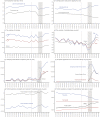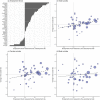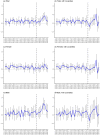The association of COVID-19 employment shocks with suicide and safety net use: An early-stage investigation
- PMID: 35324902
- PMCID: PMC8947077
- DOI: 10.1371/journal.pone.0264829
The association of COVID-19 employment shocks with suicide and safety net use: An early-stage investigation
Abstract
This paper examines whether the COVID-19-induced employment shocks are associated with increases in suicides and safety net use in the second and third quarters of 2020. We exploit plausibly exogenous regional variation in the magnitude of the employment shocks in Japan and adopt a difference-in-differences research design to examine and control for possible confounders. Our preferred point estimates suggest that a one-percentage-point increase in the unemployment rate in the second quarter of 2020 is associated with, approximately, an additional 0.52 suicides, 28 unemployment benefit recipients, 88 recipients of a temporary loan program, and 10 recipients of public assistance per 100,000 population per month. A simple calculation based on these estimates suggests that if a region experienced a one-percentage-point increase in the unemployment rate caused by the COVID-19 crisis in the second quarter of 2020, which is roughly equivalent to the third-highest regional employment shock, this would be associated with 37.4%, 60.5%, and 26.5% increases in the total, female, and male suicide rates respectively in July 2020 compared with July 2019. These results are primarily correlational rather than causal due to the limitation of our data and research design, but our baseline findings are robust to several different model specifications.
Conflict of interest statement
The authors have declared that no competing interests exist.
Figures






References
-
- Eguchi A, Nomura S, Gilmour S, Harada N, Sakamoto H, Ueda P, et al.. Suicide by gender and 10-year age groups during the COVID-19 pandemic vs previous five years in Japan: an analysis of national vital statistics. Psychiatry Research. 2021; p. 114173. doi: 10.1016/j.psychres.2021.114173 - DOI - PMC - PubMed
-
- Isumi A, Doi S, Yamaoka Y, Takahashi K, Fujiwara T. Do suicide rates in children and adolescents change during school closure in Japan? The acute effect of the first wave of COVID-19 pandemic on child and adolescent mental health. Child Abuse & Neglect. 2020;110:104680. doi: 10.1016/j.chiabu.2020.104680 - DOI - PMC - PubMed
-
- Pirkis J, John A, Shin S, DelPozo-Banos M, Arya V, Analuisa-Aguilar P, et al.. Suicide trends in the early months of the COVID-19 pandemic: an interrupted time-series analysis of preliminary data from 21 countries. The Lancet Psychiatry. 2021;. doi: 10.1016/S2215-0366(21)00091-2 - DOI - PMC - PubMed
Publication types
MeSH terms
LinkOut - more resources
Full Text Sources
Medical

